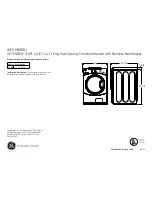
• Dirt or food remains on the crockery
This could be because:
- The wash filter is incorrectly fitted, dirt or blocked.
- The water spray arm holes are dirty or the water spray arms are blocked by a piece
of crockery.
- There is insufficient or inappropriate detergent.
- The crockery is not positioned correctly. There are pieces touching each other.
- The racks are overloaded.
- The wash program is not appropriate
- The drainage is blocked
- There was too much dried on food on the dishes.
• The crockery is whitened
This could be because:
- Insufficient detergent or rinse-aid
- A phosphate-free detergent has been used. Test using a phosphate detergent.
• The crockery does not dry
This could be because:
- There is a lack of rinse-aid
- The rinse-aid adjustment is not appropriate.
- The crockery is badly positioned
- The crockery has been removed too quickly
- The wash program is not appropriate.
• Glass looks milky or scratched
This could be because:
- The items should not be used in a dishwasher
- The detergent is not appropriate
• Glass looks opaque
- Insufficient rinse-aid
• Glasses and cutlery is blurry and glasses seem metallic
- Excessive rinse-aid
• Stainless steel or steel pieces show stains
This could be due to:
- The pieces should not be used in a dishwasher
- The crockery is badly positioned
- Too much detergent has been used
- Low quality steel.
2
PROBLEMS WITH WASH EFFICIENCY
English
25
Summary of Contents for IX LFA-013 SS
Page 75: ...V28F010H2 06 05...
















































